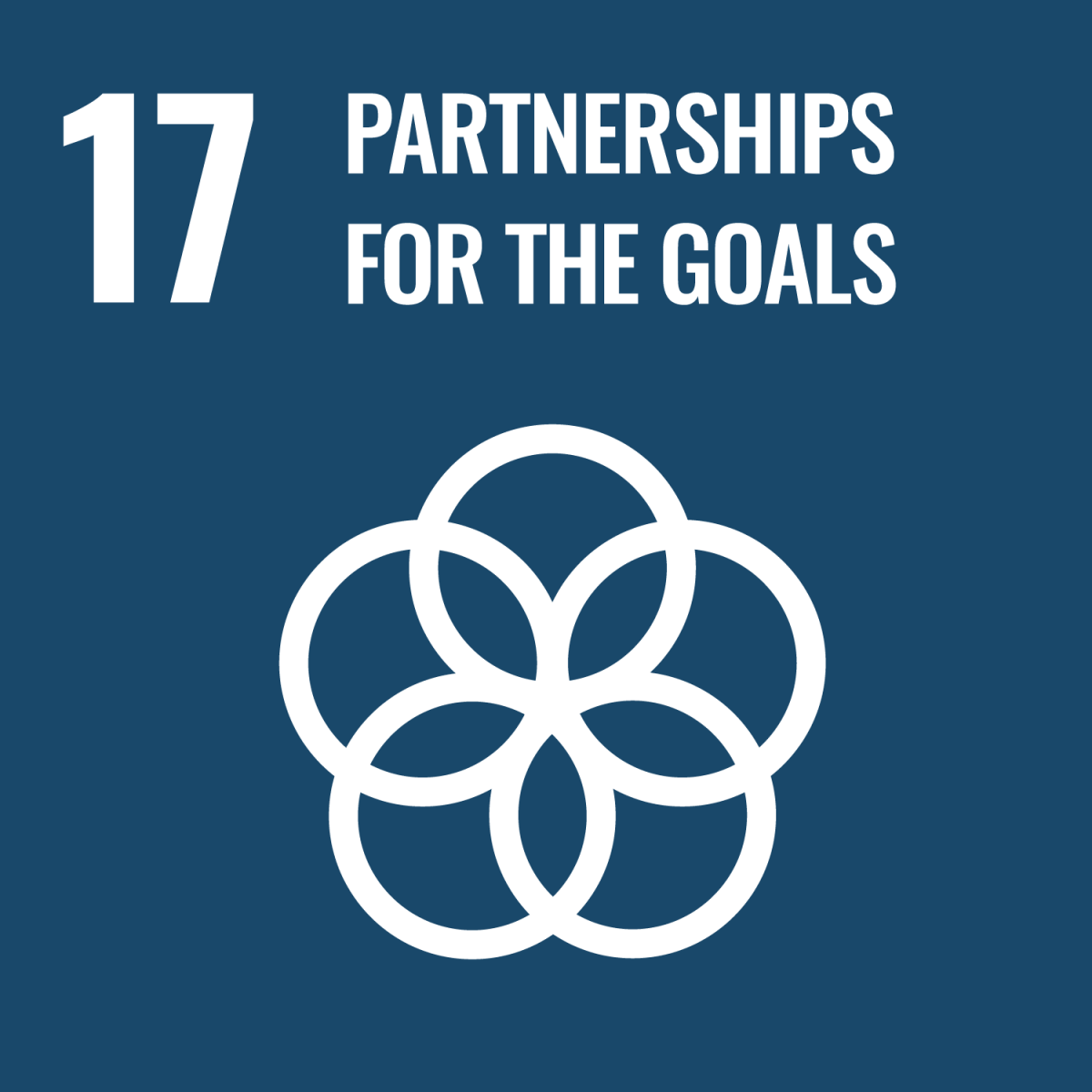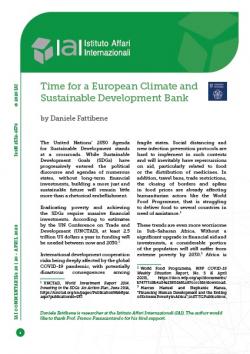Time for a European Climate and Sustainable Development Bank
Time for a European Climate and Sustainable Development Bank
Daniele Fattibene*
The United Nations’ 2030 Agenda for Sustainable Development stands at a crossroads. While Sustainable Development Goals (SDGs) have progressively entered the political discourse and agendas of numerous states, without long-term financial investments, building a more just and sustainable future will remain little more than a rhetorical embellishment.
Eradicating poverty and achieving the SDGs require massive financial investments. According to estimates by the UN Conference on Trade and Development (UNCTAD), at least 2.5 trillion US dollars a year in funding will be needed between now and 2030.[1]
International development cooperation risks being deeply affected by the global COVID-19 pandemic, with potentially disastrous consequences among fragile states. Social distancing and new infection prevention protocols are hard to implement in such contexts and will inevitably have repercussions on aid, particularly related to food or the distribution of medicines. In addition, travel bans, trade restrictions, the closing of borders and spikes in food prices are already affecting humanitarian actors like the World Food Programme, that is struggling to deliver food to several countries in need of assistance.[2]
These trends are even more worrisome in Sub-Saharan Africa. Without a significant upgrade in financial aid and investments, a considerable portion of the population will still suffer from extreme poverty by 2030.[3] Africa is particularly exposed to the current COVID-19 crisis and the United Nations Economic Commission for Africa has recently called for a 100 billion US dollar support package for its member states to tackle the pandemic.[4]
States classified as low-income countries (LICs) are most in need of development aid, yet the volume of official development assistance (ODA) dedicated to such countries has actually fallen from 30 per cent of total aid flows in 2010 to 24 per cent in 2017.[5] Moreover, LICs receive three times less foreign direct investment (FDI) than developing countries.[6] Challenges facing these states will inevitably increase due to the present COVID-19 pandemic, making emergency financial interventions even more critical.
Against this backdrop, it is more urgent than ever for the EU to find new ways to deal with development finance, not only engaging partners on a bilateral basis, but also to re-brand its visibility as a strong and united developmental actor.
This would also strengthen the EU’s ability to balance initiatives launched by several international competitors (e.g. China and Russia), particularly in Sub-Saharan Africa, where these countries are not always compliant with a human-rights based approach.
The EU has undoubtedly become a key global donor, as European development assistance represents almost 60 per cent of the total global development assistance by all OECD-DAC donors.[7] Yet, the Union still lags behind the UN target of 0.7 per cent of gross national income (GNI) allocated to ODA. The risk is that major donors could experience deep economic recession and opt for reducing foreign aid budgets, reversing a positive trend that lasted for more than two decades.[8]
There are already huge disparities among EU member states. While some countries like Sweden are well above this threshold (with 1.04 per cent allocated in 2018), the group is very fragmented. Some donors like Germany (0.61 per cent), the Netherlands (0.61 per cent) and France (0.43 per cent) are slowly improving their targets, but others like Italy (0.24 per cent) or Spain (0.20 per cent) are very far from reaching this goal.[9] In this context, it is even more striking that despite being a key global donor, the EU does not yet have a solid institutional framework that allows mobilising further public and private investments.
Reforming the EU’s financial architecture in a way that preserves inclusive and sustainable development cooperation should be part of this effort. This implies a long-term vision that overcomes the current fragmentation and could pave the way for the creation of a truly innovative European Climate and Sustainable Development Bank (ECSDB). Creating a ECSDB should be part of a broader long-term political vision that gives the EU the tools to become a true global development actor.
A first challenge for a new ECSDB is that of tackling the current fragmentation among the European Investment Bank (EIB), the European Bank for Reconstruction and Development (EBRD), the 19 European development finance institutions (DFIs) and national development banks. The latter group is also very diversified, including small actors as well as true financial giants such as the Netherlands Development Finance Company (FMO), the CDC Group plc, the Agence Française de Développement (AFD) and the German KfW.[10]
A recent report by the Wise Persons Group has proposed three concrete reform scenarios to overcome these hurdles.[11] All would lead to the creation of a ECSDB. The first and most ambitious scenario envisages the merging of the EBRD with the extra-EU activities of the EIB. The EIB already manages between 8 and 10 billion euro of funding every year, but this is spread among several fragmented beneficiaries. Meanwhile, while being more effective as a development bank, the EBRD’s mandate is limited to support economic transitions in countries in Central and Eastern Europe.
The new bank should both reduce the share of non-EU actors that are now key shareholders (i.e. the US), while requesting significant increases in resources from EU members to compensate such reduction, something that the present COVID-19 pandemic will likely make difficult. This will require long negotiations with both non-EU and EU countries, especially those who already have strong bilateral development agencies. In addition, refocusing the priorities of the EBRD towards Africa will definitely raise doubts and concerns among Central and East European countries.
Moreover, a united ECSDB would inevitably face bureaucratic resistance within the Commission. The new bank would use resources of the new Neighbourhood, Development and International Cooperation Instrument (NDICI) component of Heading VI of the next Multiannual Financial Framework 2021–2027. The risk is that this instrument could experience cuts as EU states turn to focus on internal challenges due to the pandemic. The new proposal by the President of the European Council Charles Michel confirms a decrease in resources envisaged for the NDICI, declining to 75.49 billion euro from the Commission’s original proposal of 79.22 billion.[12]
In this sense, a potential mid-term solution could be a double-track approach. On the one hand, the EU’s external development financing should be channelled through a EIB subsidiary. This should be financed by the EIB as a minority shareholder with the contribution of the European Commission, member states and national development banks. On the other hand, the EBRD should expand its geographical mandate focusing not only on Sub-Saharan Africa and climate issues, but also shifting from middle-income to low-income and fragile countries.
Such reforms will obviously take time. They require deep changes in the EBRD’s mandate and governance mechanisms, and imply that the EIB separates its external development activities from the current balance sheet. Yet, this mixed approach could not only reduce the financial burden on EU members, but would also create the needed conditions for the new bank to become a reality in the long term.
All these options will be further analysed through feasibility studies requested last December from the Council of the EU to obtain detailed information on financial, legal and operational implications stemming from the possible implementation of these scenarios.[13]
The next months will be crucial to see whether such ambitious plan will ever see the light of day. What is clear is that the Wise Persons Group report represents an important milestone in this process. Looking to the future, it is likely that the EIB will be further strengthened in the short-term, by expanding its capacity to mobilise investments in the field of sustainable development, while also differentiating it from the EBRD, which should revisit its mandate and expand further into Sub-Saharan Africa.
All in all, it is clear that the creation of a ECSDB will depend on a strong political leadership and vision from the new Commission. In times of pandemic and lacking global leadership, a strong and united ECSDB is more crucial than ever to alleviate the impact that COVID-19 will have on international development cooperation.
Building a geopolitical Union in the development sector requires the establishment of a strong and united financial institution able to mobilise development investments, such as the newly established Asian Infrastructure Investment Bank or the US Development Finance Corporation. As such, political will and financial courage will be crucial to overcome existing obstacles and succeed in the establishment of a ECSDB, finally strengthening the Union’s tools and ability to become a true leader in global development aid.
* Daniele Fattibene is researcher at the Istituto Affari Internazionali (IAI). The author would like to thank Prof. Franco Passacantando for his kind support.
[1] UNCTAD, World Investment Report 2014. Investing in the SDGs: An Action Plan, June 2014, https://unctad.org/en/pages/PublicationWebflyer.aspx?publicationid=937.
[2] World Food Programme, WFP COVID-19 Weekly Situation Report, No. 5 (6 April 2020), https://docs.wfp.org/api/documents/b74773c9b4a34e1383d681a87ccccfd6/download.
[3] Marcus Manuel and Stephanie Manea, “Financing Human Development and the Ending of Extreme Poverty in Africa”, in ETTG Publications, July 2019, https://wp.me/p9qfAP-on.
[4] UN Economic Commission for Africa, Communiqué - African Ministers of Finance - Immediate Call for $100 Billion Support and Agreement the Crisis is Deep and Recovery Will Take Much Longer, 31 March 2020, https://www.uneca.org/node/25139.
[5] Organisation for Economic Co-operation and Development (OECD), Development Aid Drops in 2018, Especially to Neediest Countries, 10 April 2019, https://www.oecd.org/newsroom/development-aid-drops-in-2018-especially-to-neediest-countries.htm.
[6] Amy Dodd, Daniel Coppard and Cecilia Caio, Investments to End Poverty 2018. Meeting the Financing Challenge to Leave No One Behind, Bristol, Development Initiatives, October 2018, https://devinit.org/8ca21b.
[7] European Commission, Europe Remains the World’s Biggest Development Donor – €74.4 billion in 2018, 11 April 2019, https://ec.europa.eu/commission/presscorner/detail/en/IP_19_2075.
[8] Raj Kumar, “For the Global Development Community, COVID-19 Poses Big Questions”, in Devex Articles, 1 April 2020, https://www.devex.com/news/96899.
[9] OECD, Development Aid Drops in 2018, Especially to Neediest Countries (2018 ODA Statistics in Detail), 10 April 2019, http://www.oecd.org/dac/financing-sustainable-development/development-finance-data/ODA-2018-detailed-summary.pdf.
[10] Benedikt Erforth and Lennart Kaplan, “The Future of European Development Finance – Institutional Reforms for Sustainable Solutions”, in DIE Briefing Papers, No. 20/2019, https://www.doi.org/10.23661/bp20.2019.v1.1.
[11] Thomas Wieser (ed.), Europe in the World. The Future of the European Financial Architecture for Development, An Independent Report by the High-Level Group of Wise Persons on the European Financial Architecture for Development, Brussels, Council of the European Union, October 2019, https://www.consilium.europa.eu/media/40967/efad-report_final.pdf.
[12] Council of the European Union, Special Meeting of the European Council - Draft Conclusions, 14 February 2020, point 116, https://drive.google.com/file/d/1UJUfO4kbV9-olQqsMPSls89lG2jnXV4t/view.
[13] Council of the European Union, Council Conclusions on Strengthening the European Financial Architecture for Development, 5 December 2019, https://data.consilium.europa.eu/doc/document/ST-14434-2019-INIT/en/pdf.

-
Details
Rome, IAI, April 2020, 5 p. -
In:
-
Issue
20|20
Topic
Tag
SDGs
Related content
-
Ricerca05/10/2017
European Think-Tanks Group (ETTG)
leggi tutto



